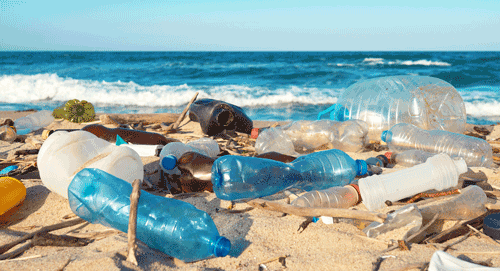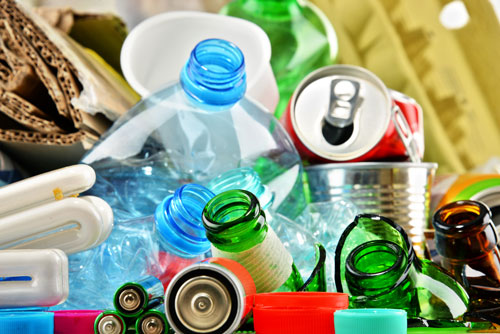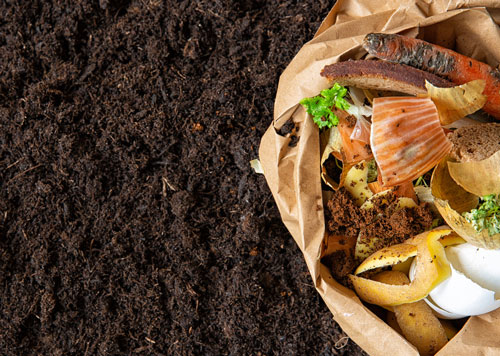Reducing waste to sustain our environment
Our other HSE article, Turning Australia’s Trash into Renewable Treasure, examined Australia’s work towards Sustainable Development Goal 12 – Responsible Consumption and Production, this article will explore another component of resource recovery and building a circular economy – reducing plastics and food waste.
Australia’s plan for plastics
Two targets set to help achieve Australia’s National Waste Policy are reducing total waste generated by 10% per person by 2030, and phasing out problematic and unnecessary plastics by 2025.
Part of successfully meeting these targets is addressing and solving Australia’s plastic problem. Research shows that in 2018-2019, Australians used 3.5 million tonnes of plastics and only 13% was recycled, with the remainder either going to landfill or leaking into oceans. It is predicted that by 2025, 99% of seabirds worldwide will have ingested plastic.
To combat the devastating effects of plastic waste, the Australian Government held a National Plastics Summit in 2020. Ideas and solutions put forth by individuals from government, industry and community sectors during the summit, informed the development of the National Plastics Plan.

An overview of the National Plastics Plan
The Plan sets out five key areas and actions to help reduce plastic waste and increase recycling rates, find alternatives to the plastics we do not need, and to reduce the amount of plastic impacting our environment. The key areas are:
1. Prevention: Addressing plastics at the source by phasing out unnecessary and problematic plastics and improving product design and packaging.
2. Recycling: Taking responsibility for our waste through investments in Australia’s plastics recycling capacity and increasing the use of recycled content.
3. Consumer education: Helping the community by educating consumers on recycling right and providing consistent kerbside collection.
4. Our oceans and waterways: Protecting our oceans, waterways, and marine life by removing plastic pollution, and reducing plastic litter and microplastics leaking into the ocean.
5. Research: Investing in new technologies and data to track how plastics flow through our economy.
Governments working towards plastics-free living
| State and Territory | Single-use plastics ban* | Container deposit scheme |
| Australian Capital Territory |
|
Yes |
| New South Wales |
|
Yes |
| Northern Territory |
|
Yes |
| Queensland |
|
Yes |
| South Australia |
|
Yes |
| Tasmania |
|
Coming |
| Victoria |
|
Coming |
| Western Australia |
|
Yes |
* Single-use plastic items include but is not limited to plastic drinking straws, cutlery, plates, stirrers, expanded polystyrene food and drink containers, and cotton bud sticks.

Reducing food waste in Australia
Food waste has a significant impact on the economy and the environment. It costs the Australian economy $36.6 billion every year, and accounts for approximately 3% of annual greenhouse gas emissions. Additionally, over 25 million hectares of land in Australia is cultivated to grow food that is wasted, with 2,600 gigalitres of water used for also growing wasted food.
Food waste does not consist only of the 3.1 million tonnes of edible food households throw away. It also includes the food that never leaves the farm, products damaged during handling, or food that is lost during transport through inadequate temperature control and storage, as well as poor management of stock in the retail and hospitality sectors, among other things. The responsibility for reducing and recovering food waste is therefore on governments, businesses, and individuals, through changes to primary production practices, commercial supply chain practices, consumer behaviours, and the provision of adequate waste collection systems, among numerous other opportunities.
The Australian Government addresses the need for change and a framework for action in the National Food Waste Strategy, and a roadmap of initiatives, commitments and partnerships. Some of the actions are already underway, while some are set for the future, to help Australia achieve its target of halving the amount of food waste sent to landfill by 2030.
Governments working to halve food waste
At a national level
Some initiatives, commitments, and partnerships already underway to halve food waste by 2030 include:
- Stop Food Waste Australia – a program to reduce wastage across the food supply chain. It delivers, among other things, the Australian Food Pact, which is a voluntary agreement between organisations such as Simplot Australia, Woolworths, Coles and Mars, that focuses on food waste prevention, food reuse and donation, and food chain transformation and innovation.
- A Voluntary Commitment Program where signatories pledge to reduce food waste at each major stage of the food value chain, such as by embedding new criteria into design and sourcing, influencing better consumer and business behaviours, and getting more value from surplus food and drink.
- Increase in the investment and support for the food rescue and relief sector so food rescue organisations can continue to reduce waste by capturing and redistributing surplus food that would otherwise go to landfill.
- Research, solutions, and education on food waste and recovery being conducted by the CSIRO and the Fight Food Waste Cooperative Research Centre.
At state and territory level
Australian Capital Territory
- A Love Food Hate Waste program aimed at raising awareness about food waste and encouraging households to find ways to avoid it.
- A Food Organics and Garden Organics (FOGO) collection pilot to encourage residents to recycle food scraps with their garden waste in their FOGO bins.
New South Wales
- A Love Food Hate Waste program and dedicated website providing ways for households, businesses, and communities to be smart about their food waste.
Queensland
- In addition to initiatives and challenges to help Queenslanders, businesses and communities reduce waste, Queensland has an Organics Strategy 2022-2032 and Organics Action Plan 2022-2032 aimed at improving the management of organic materials along the supply and consumption chains.
South Australia
- SA’s Valuing our Food Waste Strategy centres on specific actions to address food waste generated at the consumer level within industry and household sectors.
Victoria
- Part of building Victoria’s circular economy will be a four-stream waste and recycling system to help households separate food organics and garden organics from glass, mixed recyclables and household rubbish.
- Sustainability Victoria’s The Path to Half outlines solutions that Victoria can implement to help halve their food waste by 2030.
Western Australia
- Part of the State’s Waste Avoidance and Resource Recovery Strategy 2030, will be implementing a three-bin kerbside collection system by 2025 to separate food organics and garden organics from other types of waste in the Perth and Peel region.

References
- ACT Government Webpage: Container Deposit Scheme
- ACT Government Webpage: Love Food Hate Waste
- ACT Government Webpage: Food Organics and Garden Organics (FOGO)
- ACT Government Webpage: Single-use plastics
- Australian Government Publication: A Roadmap for Reducing Australia’s Food Waste by Half by 2030
- Australian Government Publication: National Food Waste Strategy
- City of Darwin Webpage: Single use Plastic
- City of Hobart Webpage: Single-use Plastics By-law Information
- Clean Up Org Webpage: State Governments Step Up and Single-Use Plastics bans gain traction
- DAWE Webpage: Consumers – Plastics in our daily lives
- DAWE Webpage: National Plastics Plan
- DAWE Webpage: Plastics
- DAWE Webpage: Prevention – Addressing Plastics at the Source
- DAWE Webpage: Recycling – Taking Responsibility for our Plastics
- DAWE Webpage: Research, Innovation and Data
- DAWE Webpage: Tackling Australia’s Food Waste
- DNRET Webpage: Container Refund Scheme
- Green Industries SA Webpage: Valuing our Food Waste
- Government of South Australia Webpage: Replace the Waste
- NSW EPA Webpage: Return and Earn
- NSW Government Webpage: Love Food Hate Waste
- NSW Government Webpage: Single-use plastics banned under new law
- NT EPA Webpage: Container deposit scheme
- NT EPA Webpage: Plastic bag ban
- Queensland Government Webpage: About the ban
- Queensland Government Publication: Organics Action Plan 2022-2023
- Queensland Government Publication: Organics Strategy 2022-2023
- Tasmania EPA Webpage: Plastic Shopping Bags Ban Act 2013
- Victorian Government Publication: The Path to Half
- Victorian Government Webpage: Container deposit scheme
- Victorian Government Webpage: Single-use plastics ban
- Victorian Government Webpage: Standardising household recycling across Victoria
- Western Australian Government Publication: Waste Avoidance and Resource Recovery Strategy 2030
- Western Australian Government Webpage: Container Deposit Scheme
- Western Australian Government Webpage: Information for Retailers
- Western Australian Government Webpage: Western Australia’s Plan for Plastics